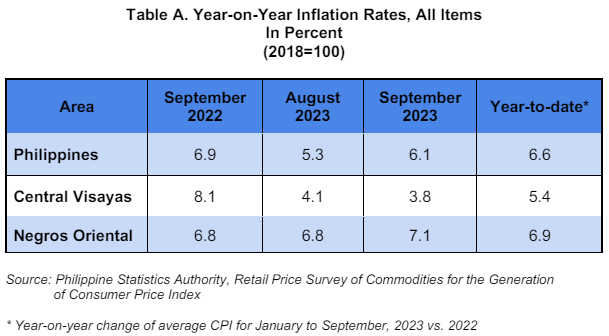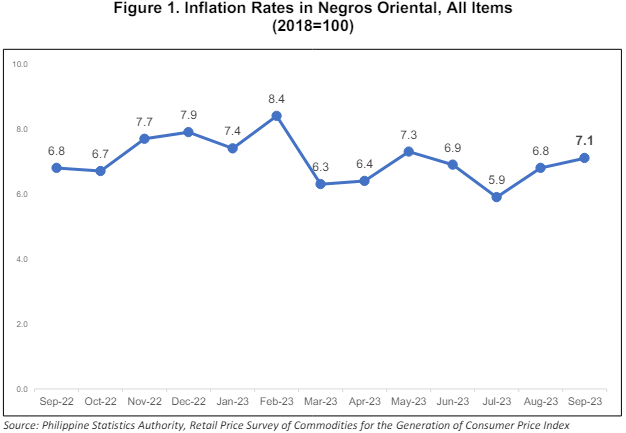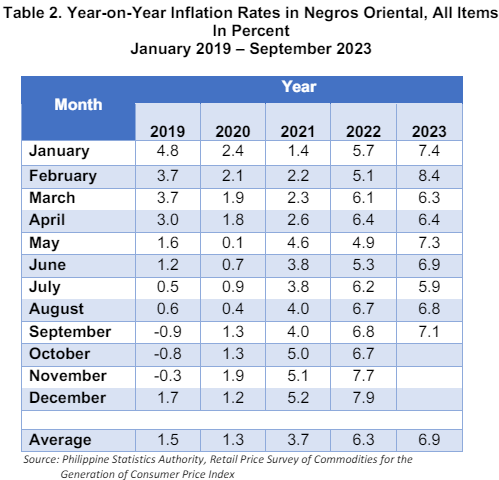Starting February 2022, the Philippine Statistics Authority (PSA) released the rebased Consumer Price Index (CPI) for all income households to base year 2018, from base year 2012 as announced in the press release number 2022-01 dated 04 January 2022. The CPI series for all income households for January 2023 onwards will be 2018-based.


A. Philippines
The country’s inflation rate has increased to 6.1 percent in September 2023 from 5.3 percent in August 2023. Despite the increase, the inflation rate in September 2022 was still high at 6.9 percent. The year-to-date average inflation rate, that is from January to September 2023, stood at 6.6 percent. (Table A)
B. Central Visayas
Central Visayas’ inflation rate has decreased to 3.8 percent in September 2023 from 4.1 percent in August 2023. In September 2022, the inflation rate was higher at 8.1 percent. (Table A)
C. Province of Negros Oriental
1. Headline Inflation
Headline inflation or the overall inflation in Negros Oriental has increased to 7.1 percent in September 2023 from 6.8 percent in August 2023. The inflation rate in September 2022 was observed at 6.8 percent. This brings the average inflation rate from January to September 2023 to 6.9 percent. (Figure 1)
The province’s inflation rate was higher than the region’s inflation rate. (Table 1)
1.1 Main Drivers to the Upward Trend of the Headline Inflation
Food and Non-Alcoholic Beverages was the one of the main contributors to the upward trend of the overall inflation during the month of September 2023 which is at 7.6 percent from 6.3 percent in August 2023. This was followed by Transport at -1.2 percent in September 2023 from -2.0 percent in August 2023.
On the contrary, lower inflation rates were observed in the following commodity groups during the month:
a. Education at 0.0 percent from 2.2 percent;
b. Health at 2.8 percent from 4.0 percent;
c. Alcoholic Beverages and Tobacco at 10.2 percent from 11.5 percent;
d. Clothing and Footwear at 5.8 percent from 7.0 percent;
e. Recreation, Sport, and Culture at 4.3 percent from 5.1 percent;
f. Restaurants and Accommodation Services at 7.0 percent from 7.6 percent;
g. Furnishing, Household Equipment and Routine Household Maintenance at 4.4 percent from 4.9 percent;
h. Information and Communication at 0.4 percent from 0.8 percent;
i. Housing, Water, Electricity, Gas and Other Fuels at 11.9 percent from 12.1 percent; and
j. Personal Care and Miscellaneous Goods and Services at 4.2 percent from 4.4 percent.
On the other hand, one commodity group has retained its previous month’s inflation rate and it was: Financial Services at 0.0 percent. (Table 3, Figure 2)
1.2 Main Contributors to the Provincial Inflation Rate
The top three commodity groups contributing to the September 2023 provincial inflation rate of 7.1 percent were the following:
a. Housing, Water, Electricity, Gas, and Other Fuels at 43.0 percent share or 3.05 percentage points;
b. Food and Non-Alcoholic Beverages with 42.0 percent share or 2.98 percentage points; and
c. Restaurants and Accommodation services at 4.9 percent share or 0.35 percentage point.
2. Food Inflation
Food inflation at the provincial level has increased to 7.7 percent in September 2023 from 6.1 percent in August 2023. In September 2022, food inflation was lower at 10.2 percent. (Tables 6 and 7)
2.1 Main Drivers to the Upward Trend of Food Inflation
The increase of food inflation in September 2023 was primarily influenced by Rice at 18.5 percent from 6.3 percent. This was followed by Fish and other seafood at 7.5 percent from 5.9 percent. Milk, other dairy products, and eggs ranked third at 9.5 percent from 6.9 percent. This was followed by Fruits and Nuts at -6.3 percent from -8.3 percent. Meat and other parts of slaughtered land animals ranked fifth at -1.7 percent from -2.2 percent. Lastly, Oils and fats ranked sixth at 11.2 percent from 10.9 percent.
Lower inflation rates during the month were also observed in the indices of the following food items: (Table 5)
a. Flour, bread and other bakery products, pasta products and other cereals at 6.9 percent from 12.2 percent;
b. Sugar, confectionery and desserts at 5.2 percent from 10.2 percent;
c. Ready-made food and other food products n.e.c at 4.5 percent from 8.9 percent;
d. Vegetables, tubers, plantains, cooking bananas and pulses at 17.2 percent from 19.6 percent; and
e. Corn at -1.8 percent from 0.3 percent.
2.2 Main Contributors to the Food Inflation
In terms of contribution to the September 2023 provincial inflation rate, food shared 40.0 percent or 2.98 percentage points. Of the food groups, the top contributors to inflation were the following:
a. Cereals and cereal products, which include rice, corn, flour, bread, and other bakery products, with 53.9 percent share or 4.15 percentage points;
b. Vegetables, tubers, plantains, cooking bananas and pulses with
18.0 percent share or 1.39 percentage points; and
c. Fish and other seafood with 17.2 percent share or 1.33 percentage points.

APPROVED BY:
(SGD.) ARIEL T. FORTUITO
Chief Statistical Specialist

